Green and Compact: A Spatial Planning Model for Knowledge-Based Urban Development in Peri-Urban Areas
Abstract
:1. Introduction
2. Background
3. Materials and Methods
4. The Spatial Planning Model
4.1. The Urban Block
- Squares and other green public spaces;
- Privately-owned public open spaces (POPOS 1) [57], which are private green spaces where mixed uses prevail on the ground floor, with active facades. The inner area of the block is accessible, with entrances on at least two sides of the block;
- Privately-owned public open spaces—2 (POPOS 2). Predominant in residential areas, in open or semi-open blocks, these green spaces allow access to non-residents but are more secluded;
- Privately-owned green spaces of restricted access. These are residential courtyards and gardens with resident-only access.
4.2. The Meso Scale: The Neighbourhood and the District
- Tree-lined streets: street, avenues, boulevards that are predominantly tree-lined and, when possible, with permeable pavements and flowerbeds on the sidewalks.
- Greenways: green corridors with pedestrians and bicycle paths, in which active mobility is the primary function.
- Linear parks: linear green spaces, providing multiple ecosystem services.
- Ecological corridor and productive green spaces (buffer strip): similar to the type above, but with buffer strips for productive uses, which can be areas of urban agriculture, agroforestry or forestry with native species.
4.3. The Regional Scale
4.4. The Spatial Planning Model across Scales
5. The Case Study: The International Hub for Sustainable Development (HIDS)
5.1. Background
5.2. The Site-Specific Data Collection
5.3. The Application of the Model
5.4. Evaluation and Validation of the Model
6. Discussion
7. Conclusions
Author Contributions
Funding
Institutional Review Board Statement
Informed Consent Statement
Acknowledgments
Conflicts of Interest
References
- United Nations. The Sustainable Development Goals Report 2020; Department of Economic and Social Affairs: New York, NY, USA, 2020. [Google Scholar]
- European Commission. Land Take in Europe. Available online: https://ec.europa.eu/environment/strategy/biodiversity-strategy-2030_en (accessed on 10 November 2021).
- Climate Action Tracker. Climate Target Updates Slow as Science Ramps up Need for Action; Climate Action Tracker: Berlin, Germany, 2021. [Google Scholar]
- Lemes de Oliveira, F.; Bezerra, M.d.C.d.L.; Teba, T.; Oliveira, A. The environment-culture-technology nexus framework: An approach for assessing the challenges and opportunities for implementing nature-based solutions in Brazil. In Nature-Based Solutions for Sustainable Urban Planning: Greening Cities, Shaping Cities; Mahmoud, I.H., Morello, E., Lemes de Oliveira, F., Geneletti, D., Eds.; Springer: Berlin/Heidelberg, Germany, 2021. [Google Scholar] [CrossRef]
- Jenks, M.; Burton, E.; Williams, K. The Compact City: A Sustainable Urban Form? E & FN Spon: London, UK, 1996; 250p. [Google Scholar]
- Bibri, S.E.; Krogstie, J.; Kärrholm, M. Compact city planning and development: Emerging practices and strategies for achieving the goals of sustainability. Dev. Built Environ. 2020, 4, 100021. [Google Scholar] [CrossRef]
- Andersson, E.; Barthel, S.; Borgstrom, S.; Colding, J.; Elmqvist, T.; Folke, C.; Gren, A. Reconnecting cities to the biosphere: Stewardship of green infrastructure and urban ecosystem services. Ambio 2014, 43, 445–453. [Google Scholar] [CrossRef] [PubMed] [Green Version]
- Rogers, R.; Gumuchdjian, P. Cities for a Small Planet; Faber and Faber: London, UK, 1997. [Google Scholar]
- Urban Task Force. Towards An Urban Renaissance: The Report of The Urban Task Force Chaired by Lord Rogers of Riverside; Urban Task Force: Sydney, Australia, 1999. [Google Scholar]
- Williams, K.; Jenks, M.; Burton, E. Achieving Sustainable Urban Form; E & FN Spon: London, UK, 2000. [Google Scholar]
- Breheny, M. Urban compaction: Feasible and acceptable? Cities 1997, 14, 209–217. [Google Scholar] [CrossRef]
- Haaland, C.; van den Bosch, C.K. Challenges and strategies for urban green-space planning in cities undergoing densification: A review. Urban For. Urban Green. 2015, 14, 760–771. [Google Scholar] [CrossRef]
- Littke, H. Planning the Green Walkable City: Conceptualizing Values and Conflicts for Urban Green Space Strategies in Stockholm. Sustainability 2015, 7, 11306–11320. [Google Scholar] [CrossRef] [Green Version]
- Tappert, S.; Klöti, T.; Drilling, M. Contested urban green spaces in the compact city: The (re-)negotiation of urban gardening in Swiss cities. Landsc. Urban Plan. 2018, 170, 69–78. [Google Scholar] [CrossRef]
- Brokking, P.; Mörtberg, U.; Balfors, B. Municipal Practices for Integrated Planning of Nature-Based Solutions in Urban Development in the Stockholm Region. Sustainability 2021, 13, 10389. [Google Scholar] [CrossRef]
- Modarres, A.; Kirby, A. The suburban question: Notes for a research program. Cities 2010, 27, 114–121. [Google Scholar] [CrossRef]
- Artmann, M.; Inostroza, L.; Fan, P. Urban sprawl, compact urban development and green cities. How much do we know, how much do we agree? Ecol. Indic. 2019, 96, 3–9. [Google Scholar] [CrossRef]
- Wellmann, T.; Schug, F.; Haase, D.; Pflugmacher, D.; van der Linden, S. Green growth? On the relation between population density, land use and vegetation cover fractions in a city using a 30-years Landsat time series. Landsc. Urban Plan. 2020, 202, 103857. [Google Scholar] [CrossRef]
- European Commission. Green Infrastructure; European Commission: Luxembourg, 2010.
- European Commission. Towards An EU Research and Innovation Policy Agenda for Nature-Based Solutions & Re-Naturing Cities—Final Report of the Horizon 2020 Expert Group on ‘Nature Based Solutions and Re-Naturing Cities’; European Commission: Luxembourg, 2015.
- Lee, A.C.K.; Maheswaran, R. The health benefits of urban green spaces: A review of the evidence. J. Public Health 2011, 33, 212–222. [Google Scholar] [CrossRef]
- Kabisch, N.; van den Bosch, M.; Lafortezza, R. The health benefits of nature-based solutions to urbanization challenges for children and the elderly—A systematic review. Environ. Res. 2017, 159, 362–373. [Google Scholar] [CrossRef] [PubMed]
- Ward Thompson, C.; Roe, J.; Aspinall, P.; Mitchell, R.; Clow, A.; Miller, D. More green space is linked to less stress in deprived communities: Evidence from salivary cortisol patterns. Landsc. Urban Plan. 2012, 105, 221–229. [Google Scholar] [CrossRef] [Green Version]
- Soga, M.; Gaston, K.J. Extinction of experience: The loss of human-nature interactions. Front. Ecol. Environ. 2016, 14, 94–101. [Google Scholar] [CrossRef] [Green Version]
- da Schio, N.; Phillips, A.; Fransen, K.; Wolff, M.; Haase, D.; Ostoić, S.K.; Živojinović, I.; Vuletić, D.; Derks, J.; Davies, C.; et al. The impact of the COVID-19 pandemic on the use of and attitudes towards urban forests and green spaces: Exploring the instigators of change in Belgium. Urban For. Urban Green. 2021, 65, 127305. [Google Scholar] [CrossRef]
- Uchiyama, Y.; Kohsaka, R. Access and use of green areas during the covid-19 pandemic: Green infrastructure management in the “new normal”. Sustainability 2020, 12, 9842. [Google Scholar] [CrossRef]
- Haase, D.; Larondelle, N.; Andersson, E.; Artmann, M.; Borgstrom, S.; Breuste, J.; Gomez-Baggethun, E.; Gren, A.; Hamstead, Z.; Hansen, R.; et al. A quantitative review of urban ecosystem service assessments: Concepts, models, and implementation. Ambio 2014, 43, 413–433. [Google Scholar] [CrossRef] [Green Version]
- Kabisch, N.; Frantzeskaki, N.; Pauleit, S.; Naumann, S.; Davis, M.; Artmann, M.; Haase, D.; Knapp, S.; Korn, H.; Stadler, J.; et al. Nature-based solutions to climate change mitigation and adaptation in urban areas: Perspectives on indicators, knowledge gaps, barriers, and opportunities for action. Ecol. Soc. 2016, 21, 39. [Google Scholar] [CrossRef] [Green Version]
- Kabisch, N.; Korn, H.; Stadler, J.; Bonn, A. Nature-Based Solutions to Climate Change Adaptation in Urban Areas: Linkages between Science, Policy and Practice; Springer: Amsterdam, The Netherland, 2017. [Google Scholar]
- European Commission. EU Biodiversity Strategy for 2030. Available online: https://www.eea.europa.eu/policy-documents/eu-biodiversity-strategy-for-2030-1 (accessed on 10 November 2021).
- Echenique, M.H.; Hargreaves, A.J.; Mitchell, G.; Namdeo, A. Growing Cities Sustainably: Does Urban Form Really Matter? J. Am. Plan. Assoc. 2012, 78, 121–137. [Google Scholar] [CrossRef]
- Frey, H. Designing The City: Towards a More Sustainable Urban Form; E & FN Spon: London, UK, 1998. [Google Scholar]
- Cortinovis, C.; Geneletti, D. Ecosystem services in urban plans: What is there, and what is still needed for better decisions. Land Use Policy 2018, 70, 298–312. [Google Scholar] [CrossRef]
- Lemes de Oliveira, F. Green Wedge Urbanism: History, Theory and Contemporary Practice; Bloomsbury: London, UK, 2017. [Google Scholar]
- Lemes de Oliveira, F. Towards a Spatial Planning Framework for the Re-naturing of Cities. In Planning Cities with Nature: Theories, Strategies and Methods; Lemes de Oliveira, F., Mell, I., Eds.; Springer: Amsterdam, The Netherland, 2019; pp. 81–95. [Google Scholar]
- Artmann, M.; Kohler, M.; Meinel, G.; Gan, J.; Ioja, I.-C. How smart growth and green infrastructure can mutually support each other—A conceptual framework for compact and green cities. Ecol. Indic. 2019, 96, 10–22. [Google Scholar] [CrossRef]
- Richter, B.; Behnisch, M. Integrated evaluation framework for environmental planning in the context of compact green cities. Ecol. Indic. 2019, 96, 38–53. [Google Scholar] [CrossRef]
- D’Acci, L. A new type of cities for liveable futures. Isobenefit Urbanism morphogenesis. J. Environ. Manag. 2019, 246, 128–140. [Google Scholar] [CrossRef] [PubMed] [Green Version]
- Orsi, F. Centrally located yet close to nature: A prescriptive agent-based model for urban design. Comput. Environ. Urban Syst. 2019, 73, 157–170. [Google Scholar] [CrossRef]
- Hamdan, D.M.A.; Lemes De Oliveira, F. Urban planning and nature: Parametric modelling as a tool for responsive greening of cities. In Planning for Transition: AESOP 2019 Conference—Book of Papers; Association of European Schools of Planning: Portsmouth, UK, 2019; pp. 1143–1155. [Google Scholar]
- Romero-Duque, L.P.; Trilleras, J.M.; Castellarini, F.; Quijas, S. Ecosystem services in urban ecological infrastructure of Latin America and the Caribbean: How do they contribute to urban planning? Sci. Total Environ. 2020, 728, 138780. [Google Scholar] [CrossRef]
- Costa, S.M.F.D.; Forlin, L.G.; Carmo, M.B.S.; Silva, R.L.D. Study of gated communities in Brazil: New developments and typologies in the Paraíba Valley, SP. Bol. De Geogr. 2014, 32, 87. [Google Scholar] [CrossRef] [Green Version]
- Villaça, F. São Paulo: Urban segregation and inequality. Estud. Avançados 2011, 25, 37–58. [Google Scholar] [CrossRef] [Green Version]
- Polidoro, M.; de Lollo, J.A.; Barros, M.V.F. Environmental impacts of urban sprawl in Londrina, Paraná, Brazil. J. Urban Environ. Eng. 2011, 5, 73–83. [Google Scholar] [CrossRef]
- Torres, H.; Alves, H.; Aparecida De Oliveira, M. São Paulo peri-urban dynamics: Some social causes and environmental consequences. Environ. Urban. 2007, 19, 207–223. [Google Scholar] [CrossRef] [Green Version]
- Yigitcanlar, T.; Velibeyoglu, K.; Baum, S. (Eds.) Knowledge-Based Urban Development: Planning and Applications in the Information Era; IGI Global: Hershey, PA, USA, 2008; 23p, ISBN 978-1-59904-720-1. [Google Scholar]
- Magdaniel, F.C. Campuses, Cities and Innovation: 39 International Cases Accommodating Tech-Based Research; TU Delft, Faculty of Architecture, Department of Management in the Built Environment: Delft, The Netherlands, 2018. [Google Scholar]
- Esmaeilpoorarabi, N.; Yigitcanlar, T.; Guaralda, M.; Kamruzzaman, M. Evaluating place quality in innovation districts: A Delphic hierarchy process approach. Land Use Policy 2018, 76, 471–486. [Google Scholar] [CrossRef]
- van Aken, J.E.; Romme, G. Reinventing the future: Adding design science to the repertoire of organization and management studies. Organ. Manag. J. 2009, 6, 5–12. [Google Scholar] [CrossRef]
- Dresch, A.; Lacerda, D.P.; Valle Antunes, J.A., Jr. (Eds.) Design Science Research: A Method for Science and Technology Advancement; Springer: Berlin/Heidelberg, Germany, 2015. [Google Scholar]
- March, S.T.; Smith, G.F. Design and natural science research on information technology. Decis. Support Syst. 1995, 15, 251–266. [Google Scholar] [CrossRef]
- Lenzholzer, S.; Duchhart, I.; Koh, J. ‘Research through designing’ in landscape architecture. Landsc. Urban Plan. 2013, 113, 120–127. [Google Scholar] [CrossRef]
- Roggema, R. Research by Design: Proposition for a Methodological Approach. Urban Sci. 2017, 1, 2. [Google Scholar] [CrossRef]
- Nassauer, J.; Opdam, P. Design in science: Extending the landscape ecology paradigm. Landsc. Ecol. 2008, 23, 633–644. [Google Scholar] [CrossRef]
- Sanches, P. Cidades Compactas e Mais Verdes: Conciliando Densidade Urbana e Vegetação Por Meio do Desenho Urbano; Universidade de São Paulo: Piracicaba, Brazil, 2020. [Google Scholar]
- Madureira, H.; Monteiro, A. Going Green and Going Dense: A Systematic Review of Compatibilities and Conflicts in Urban Research. Sustainability 2021, 13, 10643. [Google Scholar] [CrossRef]
- Kayden, J. Privetly-Owned Public Space; Wiley: New York, NY, USA, 2000. [Google Scholar]
- Bentrup, G. Conservation Buffers—Design Guidelines for Buffers, Corridors, and Greenways; Department of Agriculture, Forest Service: Asheville, NC, USA, 2008. [Google Scholar]
- Cook, E.A.; Van Lier, H.N. Landscape Planning and Ecological Networks: Developments in Landscape Management and Urban Planning; Elsevier: Amsterdam, The Netherland, 1994. [Google Scholar]
- Fernández-juricic, E. Avian spatial segregation at edges and interiors of urban parks in Madrid, Spain. Biodivers. Conserv. 2001, 10, 1303–1316. [Google Scholar] [CrossRef]
- MacGregor-Fors, I.; Schondube, J.E. Gray vs. green urbanization: Relative importance of urban features for urban bird communities. Basic Appl. Ecol. 2011, 12, 372–381. [Google Scholar] [CrossRef]
- Korhonen, J.; Honkasalo, A.; Seppala, J. Circular Economy: The Concept and its Limitations. Ecol. Econ. 2018, 143, 37–46. [Google Scholar] [CrossRef]
- Skar, S.L.G.; Pineda-Martos, R.; Timpe, A.; Polling, B.; Bohn, K.; Kulvik, M.; Delgado, C.; Pedras, C.M.G.; Paco, T.A.; Cujic, M.; et al. Urban agriculture as a keystone contribution towards securing sustainable and healthy development for cities in the future. Blue-Green Syst. 2020, 2, 1–27. [Google Scholar] [CrossRef] [Green Version]
- Ortega-Álvarez, R.; MacGregor-Fors, I. Living in the big city: Effects of urban land-use on bird community structure, diversity, and composition. Landsc. Urban Plan. 2009, 90, 189–195. [Google Scholar] [CrossRef]
- Gyurkovics, J.; Lukovics, M. Generations of Science Parks in the Light of Responsible Innovation. In Responsible Innovation; Buzás, N., Lukovics, M., Eds.; University of Szeged, Faculty of Economics and Business Administration: Szeged, Hungary, 2014; pp. 193–208. [Google Scholar]
- A+T Research Group. 50 Urban Blocks; A+T Architecture Publishers: Vitoria-Gasteiz, Spain, 2017. [Google Scholar]
- Roggema, R. From Nature-Based to Nature-Driven: Landscape First for the Design of Moeder Zernike in Groningen. Sustainability 2021, 13, 2368. [Google Scholar] [CrossRef]
- Farr, D. Sustainable Urbanism: Urban Design with Nature; John Wiley & Sons: Hoboken, NJ, USA, 2011. [Google Scholar]
- Gehl, J. Cities for People; Island Press: Washington, DC, USA, 2013. [Google Scholar]
- Pont, M.B.; Haupt, P.A. Spacematrix. Space, Density and Urban Form; NAi Publishers: Rotterdam, The Netherlands, 2010. [Google Scholar]
- Hedblom, M.; Andersson, E.; Borgström, S. Flexible land-use and undefined governance: From threats to potentials in peri-urban landscape planning. Land Use Policy 2017, 63, 523–527. [Google Scholar] [CrossRef]
- Salvati, L.; Ranalli, F.; Gitas, I. Landscape fragmentation and the agro-forest ecosystem along a rural-to-urban gradient: An exploratory study. Int. J. Sust. Dev. World 2014, 21, 160–167. [Google Scholar] [CrossRef]
- Johnston, A. The roles of universities in knowledge-based urban development: A critical review. Int. J. Knowl.-Based Dev. 2019, 10, 213–231. [Google Scholar] [CrossRef]
- Hansen, R.; Olafsson, A.S.; van der Jagt, A.P.N.; Rall, E.; Pauleit, S. Planning multifunctional green infrastructure for compact cities: What is the state of practice? Ecol. Indic. 2019, 96, 99–110. [Google Scholar] [CrossRef]
- Mahmoud, I.H.; Morello, E.; Ludlow, D.; Salvia, G. Co-creation Pathways to Inform Shared Governance of Urban Living Labs in Practice: Lessons from Three European Projects. Front. Sustain. Cities 2021, 3, 690458. [Google Scholar] [CrossRef]
- Wagner, J.; Davies, S.; Sorring, N.; Vey, J. Advancing a New Wave of Urban Competitiveness: The Role of Mayors in the Rise of Innovation Districts; Brookings: Washington, DC, USA, 2017. [Google Scholar]
- Wagner, J.; Watch, D. Innovation Spaces: The New Design of Work; Anne, T., Robert, M., Eds.; Bass Initiative on Innovation and Placemaking at Brookings: Washington, DC, USA, 2017. [Google Scholar]
- Vey, J.; Hachadorian, J.; Wagner, J.; Andes, S.; Storring, N. Assessing Your Innovation District: A How-to Guide. Brookings Institute. Available online: https://www.brookings.edu/research/assessing-your-innovation-district-a-how-to-guide (accessed on 11 November 2021).
- Deksissa, T.; Trobman, H.; Zendehdel, K.; Azam, H. Integrating Urban Agriculture and Stormwater Management in a Circular Economy to Enhance Ecosystem Services: Connecting the Dots. Sustainability 2021, 13, 8293. [Google Scholar] [CrossRef]
- Kampelmann, S. Wood works: How local value chains based on urban forests contribute to place-based circular economy. Urban Geogr. 2020, 41, 911–914. [Google Scholar] [CrossRef]
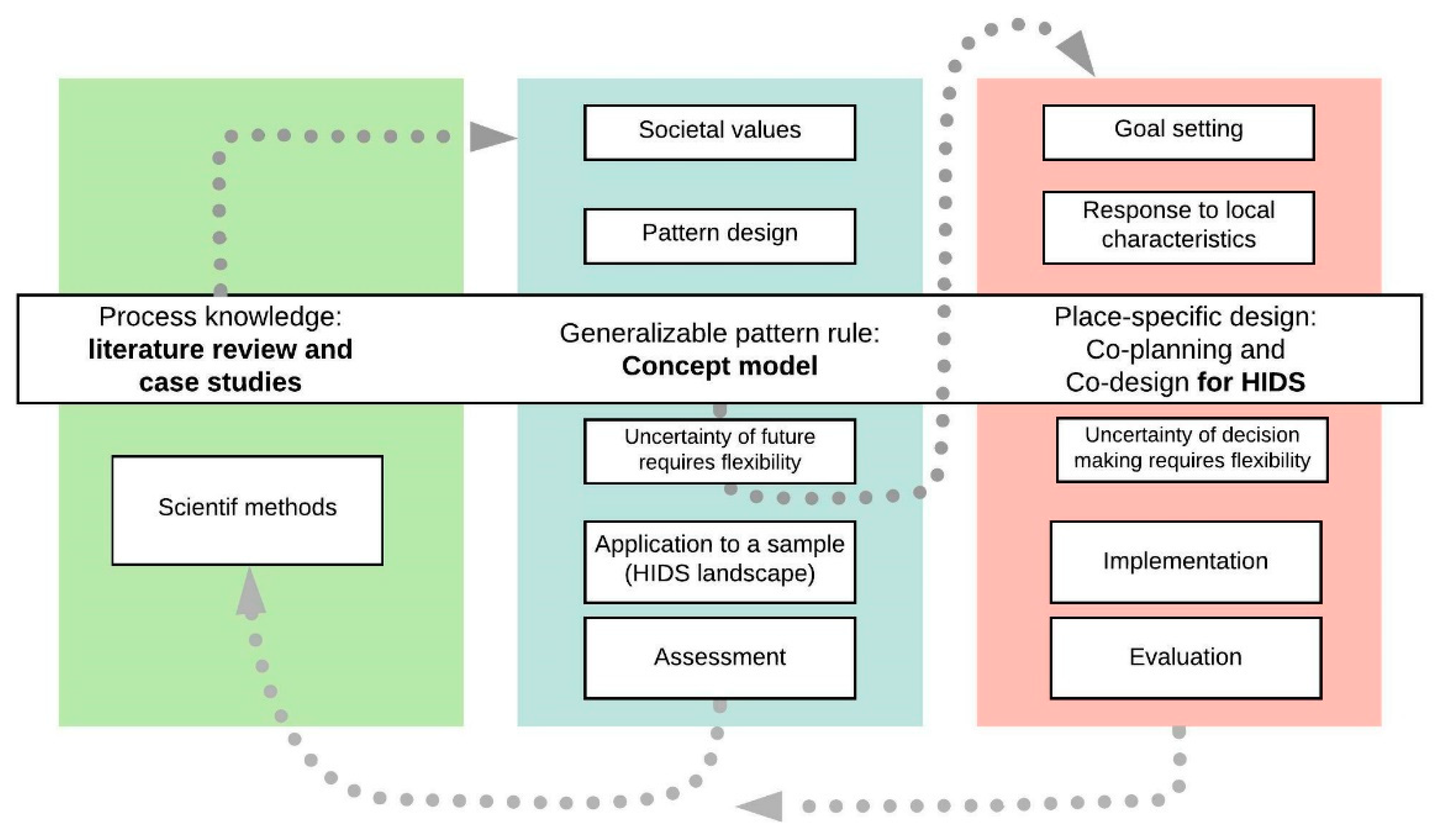

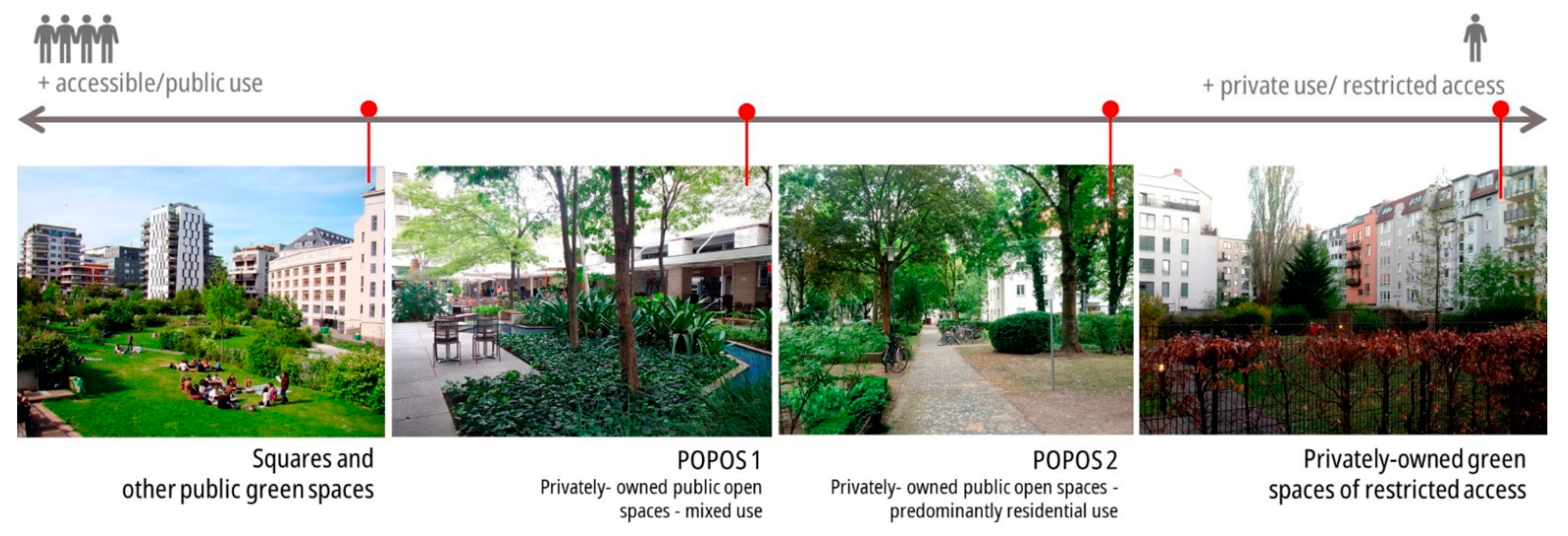
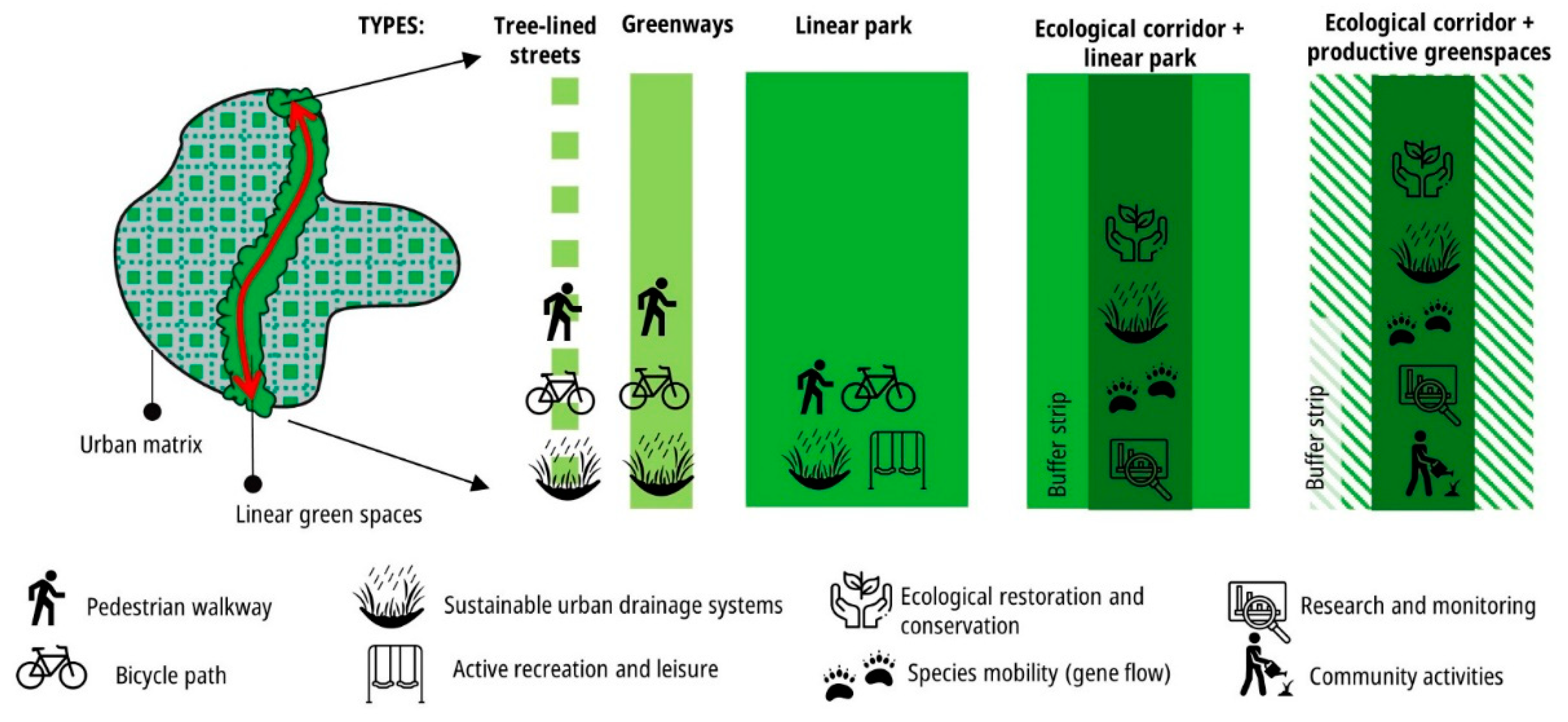
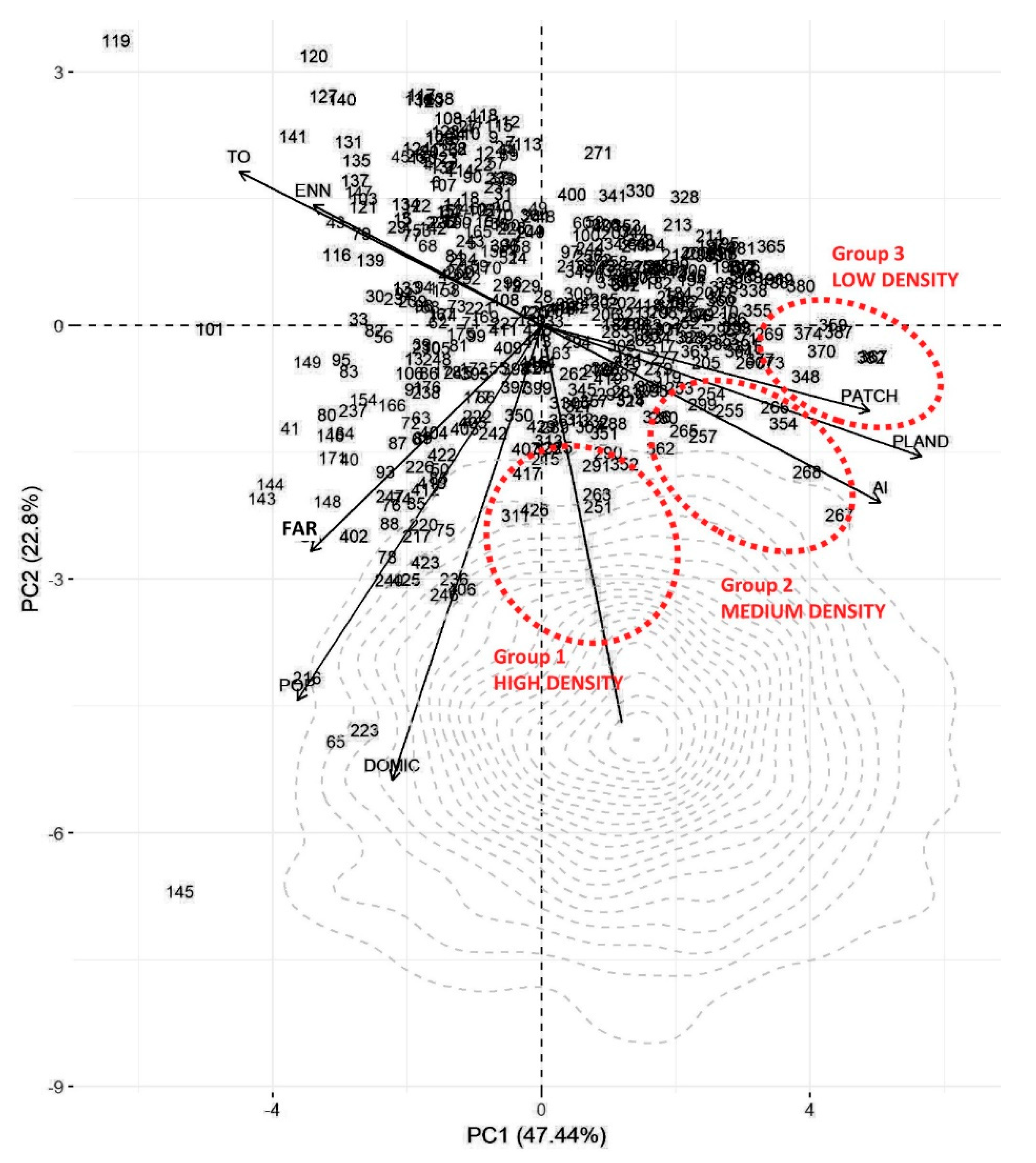

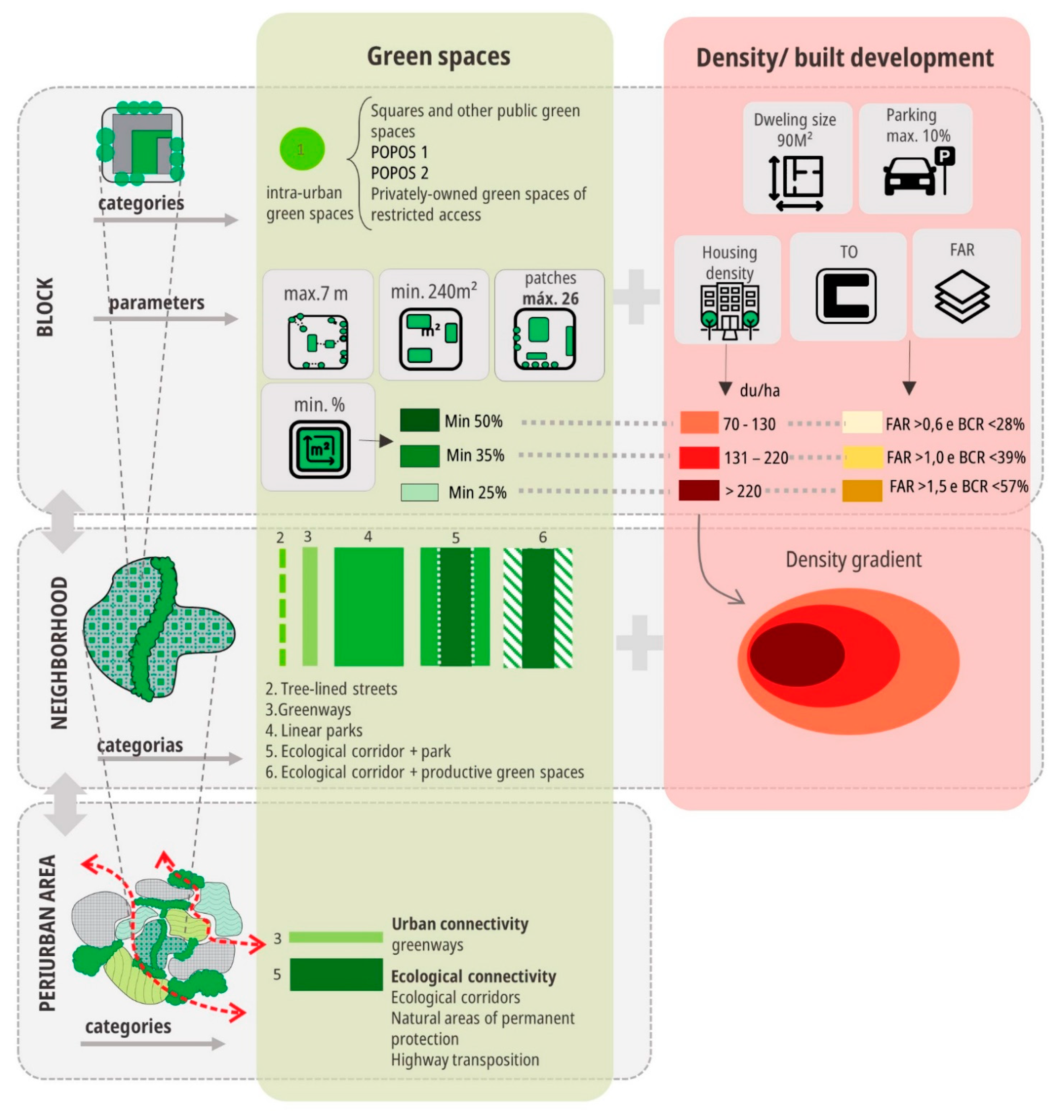

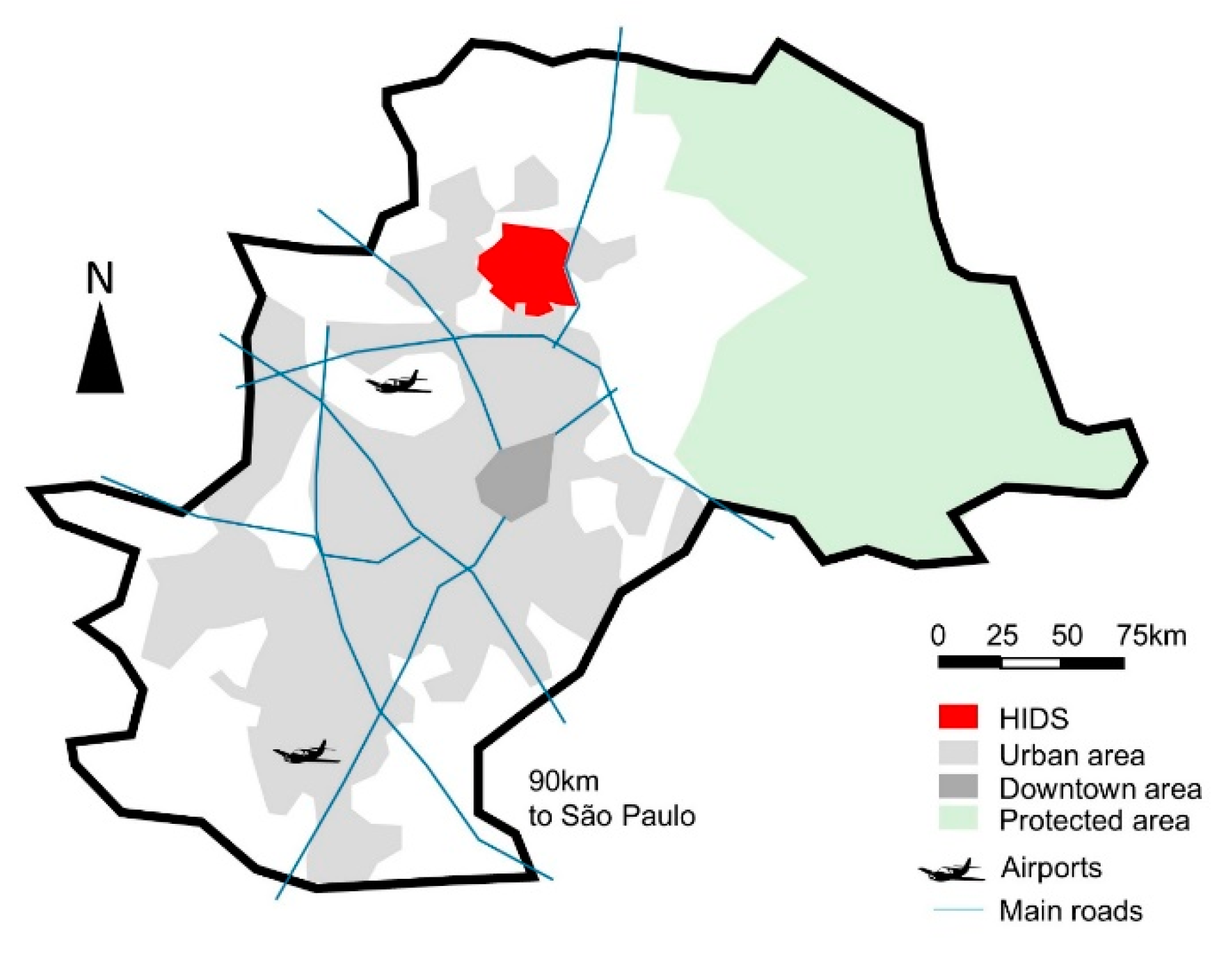

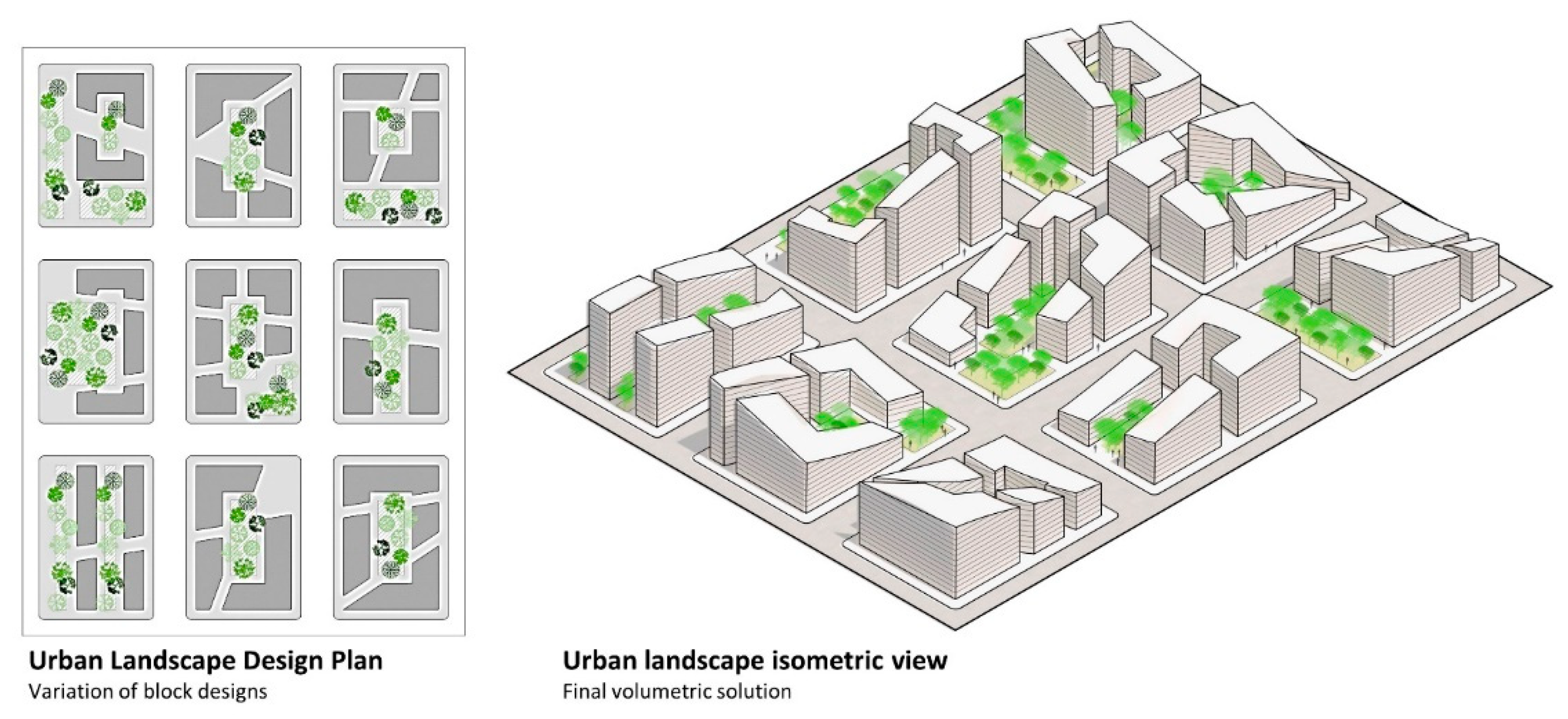

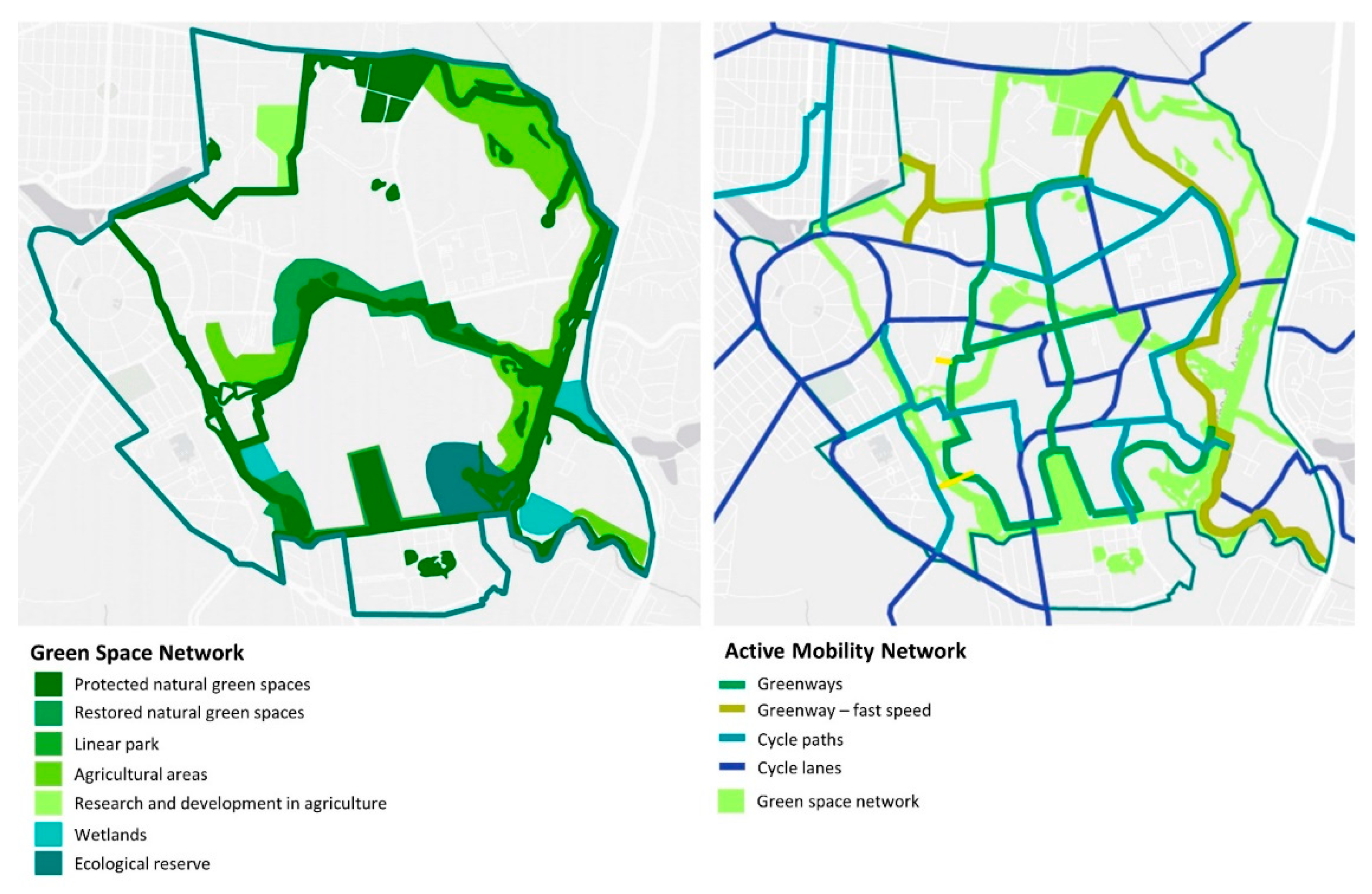
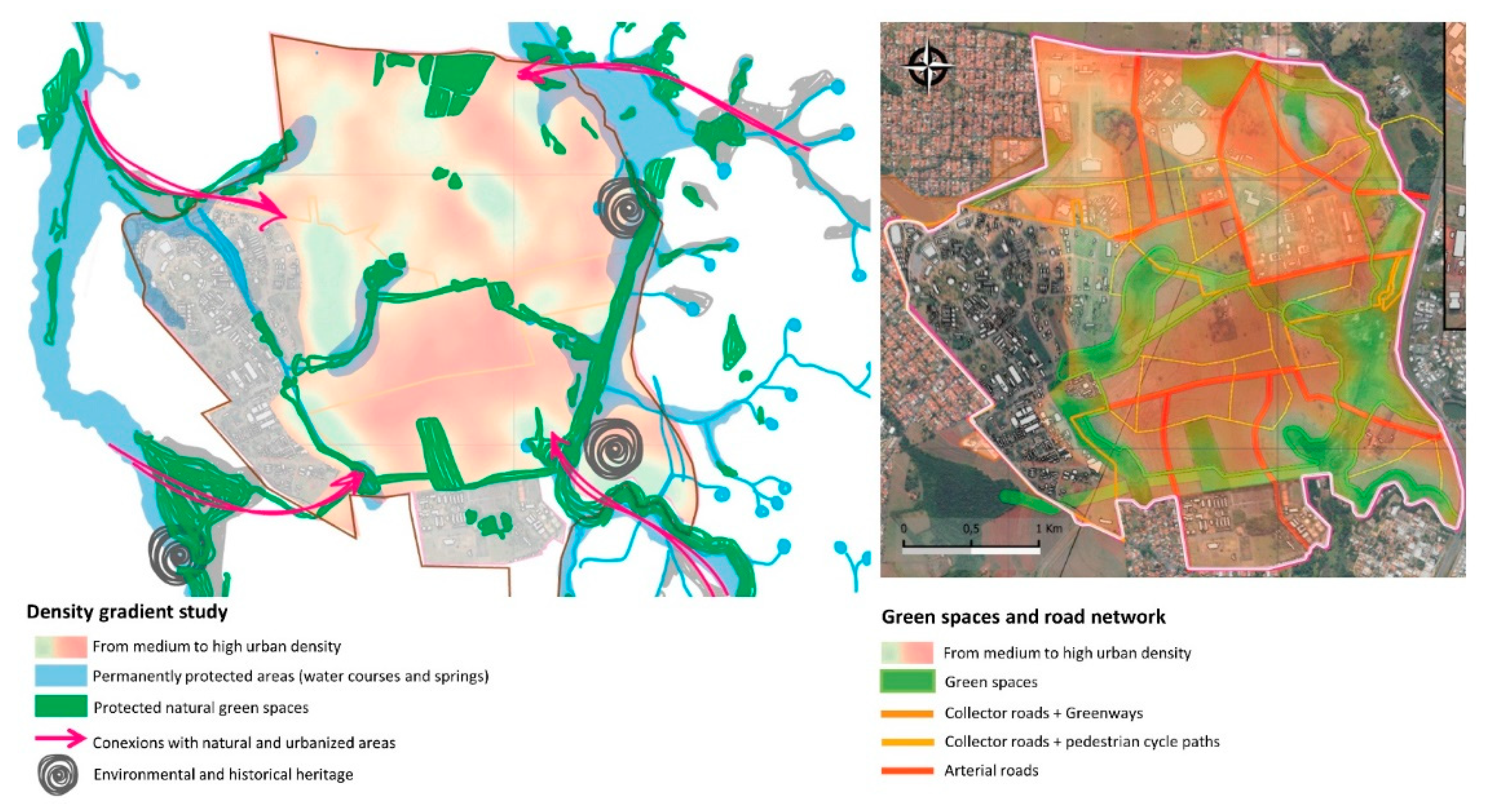
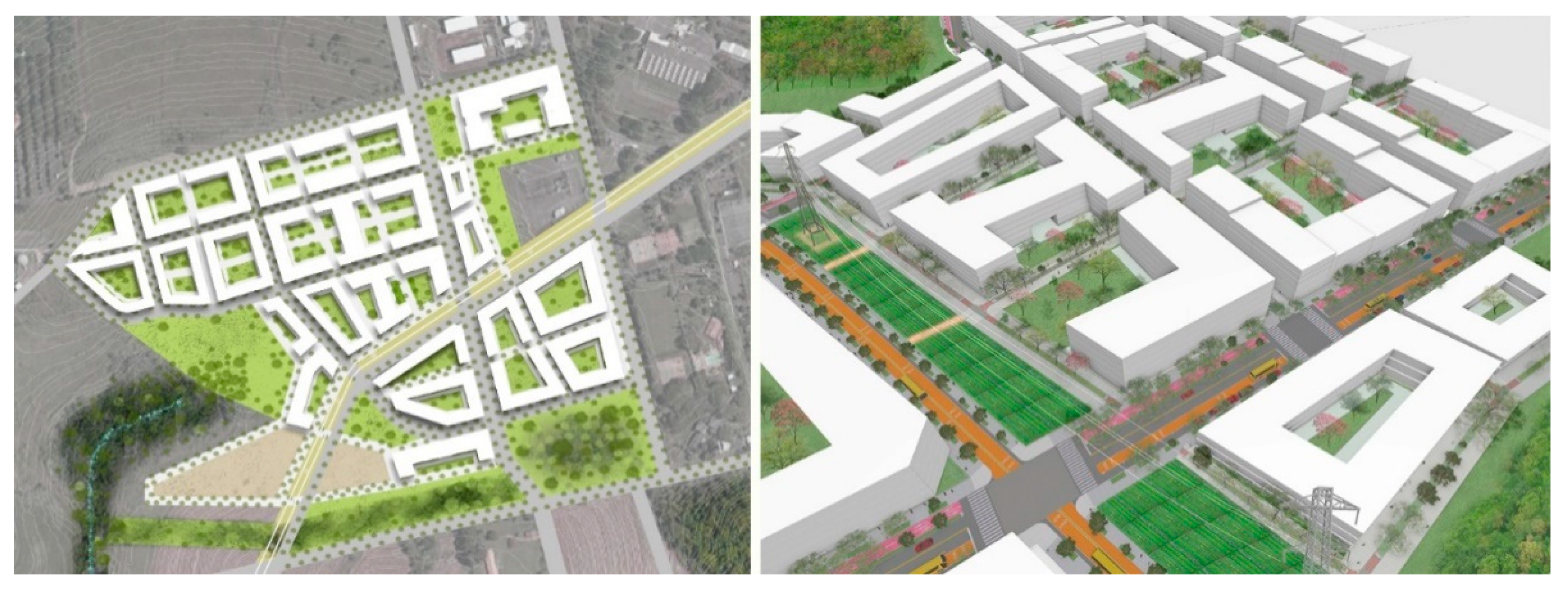
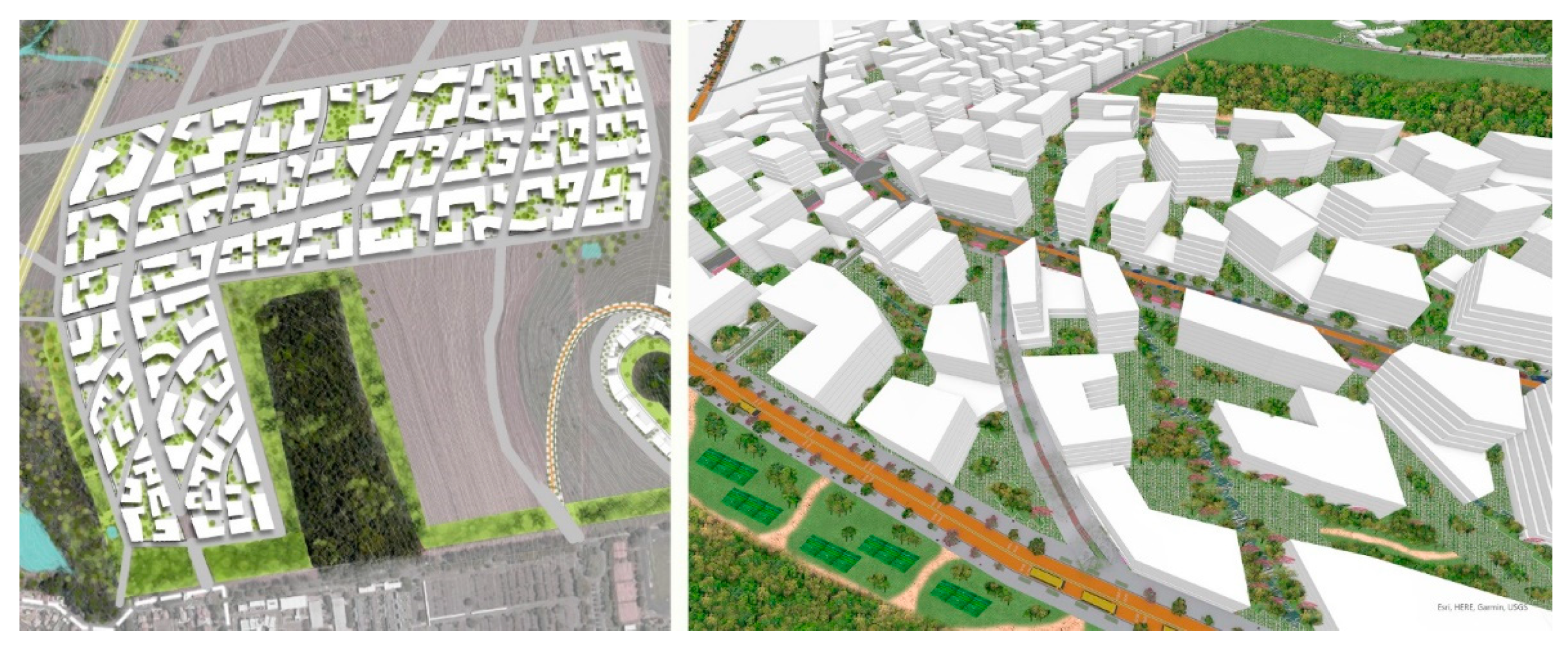
| Parameters/Centrality | Central Plateau (per Block) | South Centre |
|---|---|---|
| Green space area | 35% | 20% |
| BCR | 50% | 55% |
| FAR | 2,5/3,5 | 2,5/3,5 |
| Housing density | 136 du/ha/197du/ha | 212 du/ha/285 du/ha |
| Parking area | No data | Up to 10% |
| Average dwelling size | 100 m2 | 100 m2 |
Publisher’s Note: MDPI stays neutral with regard to jurisdictional claims in published maps and institutional affiliations. |
© 2021 by the authors. Licensee MDPI, Basel, Switzerland. This article is an open access article distributed under the terms and conditions of the Creative Commons Attribution (CC BY) license (https://creativecommons.org/licenses/by/4.0/).
Share and Cite
Sanches, P.; Lemes de Oliveira, F.; Celani, G. Green and Compact: A Spatial Planning Model for Knowledge-Based Urban Development in Peri-Urban Areas. Sustainability 2021, 13, 13365. https://doi.org/10.3390/su132313365
Sanches P, Lemes de Oliveira F, Celani G. Green and Compact: A Spatial Planning Model for Knowledge-Based Urban Development in Peri-Urban Areas. Sustainability. 2021; 13(23):13365. https://doi.org/10.3390/su132313365
Chicago/Turabian StyleSanches, Patricia, Fabiano Lemes de Oliveira, and Gabriela Celani. 2021. "Green and Compact: A Spatial Planning Model for Knowledge-Based Urban Development in Peri-Urban Areas" Sustainability 13, no. 23: 13365. https://doi.org/10.3390/su132313365






